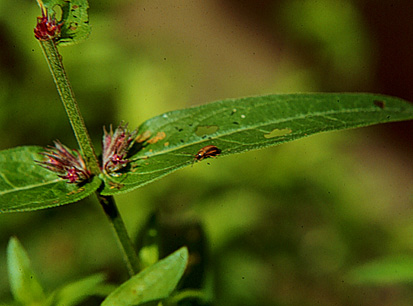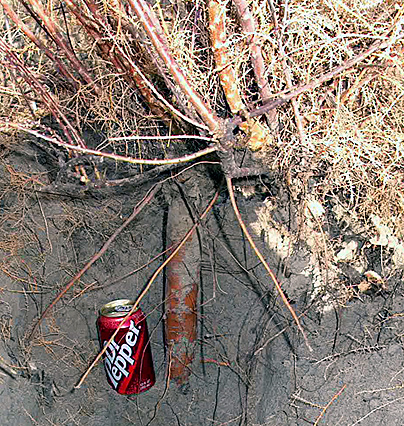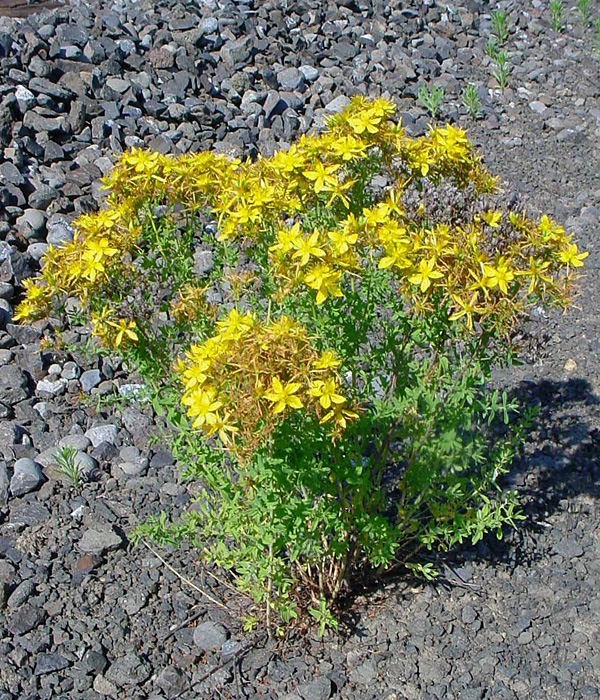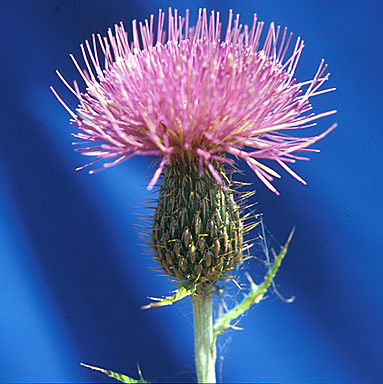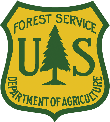State Listed Noxious Weed
Leafy spurge was once the most difficult noxious weed to control in North Dakota and infests all 53 counties. Scientists at the North Dakota Agricultural College (NDAC) recognized leafy spurge could be a problem soon after it was first identified in the state, growing along a Fargo street in 1909. However, the plant was not added to the state noxious weed list until 1935, when leafy spurge was found growing in all but 10 counties. The largest single infestation at that time was estimated to be 193 acres in Foster County.
Despite several control programs led by the State Agriculture Department and NDSU Extension, leafy spurge doubled in acreage every 10 years, reaching nearly 1.8 million acres in the 1980s. A coordinated integrated program of biological, chemical and cultural methods directly led to the first-ever reports of a decline in leafy spurge infestation in the state in the 1990s.
Identification and growth form:
Leafy spurge is a long-lived perennial that normally grows 2 to 3 feet tall from a woody crown from below the soil surface. Each crown area produces several upright stems, giving the plant a clumplike appearance. The plant bears numerous linear-shaped leaves with smooth margins. The leaves have a characteristic bluish-green color but turn yellow or reddish orange in the fall. Stems originating from crown buds and roots begin growth in late April, making leafy spurge one of the first plants to emerge in the spring. The early and rapid growth gives leafy spurge a competitive advantage over crop and pasture plants. All parts of the plant contain a milky juice called latex, which is a useful identifying characteristic.
Leafy spurge produces a flat-topped cluster of yellowish-green petal-like structures called bracts, which surround the true flowers. The showy, yellow bracts appear in late May and early June, giving the plant the appearance of “blooming.” However, the true flowers, which are small and green, do not develop until mid-June. Spring-applied herbicides are more effective on plants with developing true flower parts than on plants with developed bracts but undeveloped flowers.
Seeds are borne in pods, which contain three gray-brown, oblong, smooth seeds. After the seed has matured, the seed pods burst explosively and throw seeds up to 15 feet from the parent plant. An average of 140 seeds is produced per stem, and seeds may remain viable in the soil at least eight years.
Leafy spurge seeds may germinate to re-establish infestations where total control of leafy spurge tops and roots has been achieved. The peak period of germination is late May and early June, but seeds can germinate and seedlings become established throughout the growing season. Leafy spurge seedlings have a remarkable capacity for vegetative reproduction and can reproduce vegetatively within seven to 10 days after emergence. Seedlings typically do not flower during the first year.
The root system of leafy spurge is extensive and consists of numerous coarse and fine roots that occupy a large volume of soil. Roots are most abundant in the upper foot of soil, but some roots can extend to a depth of 15 feet or more. The roots are woody and durable in structure, with numerous buds capable of producing new shoots. The root system contains a large nutrient reserve capable of sustaining the plant for years.
Why is this plant a concern?
Leafy spurge infestations may have more than 200 stems per square yard in sandy soil and even higher densities in heavy clay soil. Patches of leafy spurge usually spread vegetatively from 1 to 3 feet per year and form dense stands that crowd out other plants by shading and competing for moisture and nutrients. Forage production may be reduced to 20 percent or less and most native plants are eliminated because they cannot out-compete this weed.
Leafy spurge contains a toxic substance that, when consumed by livestock, is an irritant, emetic and purgative. It causes scours and weakness in cattle and may result in death. The toxin has produced inflammation and loss of hair on the feet of horses from freshly mowed stubble during haying and has caused mortality of sheep that grazed leafy spurge exclusively. However, sheep and goats will graze leafy spurge as a portion of their diet and can be used as a form of cultural control. Animals will eat dried plants in hay, but many livestock, particularly cattle, avoid eating live plants
How do I control this plant?
Leafy spurge control must be considered a long-term management program. Generally, less than 6 inches of the root system is destroyed regardless if the control method is biological, chemical or cultural. Research at North Dakota State University has shown that more of the root system is killed when a combination of control methods are used, compared with any method used alone.
Chemical. Proper timing of herbicide applications is essential for good leafy spurge control. Leafy spurge is most susceptible to dicamba (Banvel and other trade names), Facet L (quinclorac), Method (aminocyclopyrachlor), and Tordon (picloram). Plateau (imazapic), fall-applied, provides better long-term control and less grass injury than spring or summer treatments. Combinations of Tordon plus Plateau or Tordon plus Plateau plus 2,4-D applied in June provide improved leafy spurge control compared with Tordon plus 2,4-D or Plateau applied alone in June. The Tordon plus Plateau combination is not recommended for use in the fall.
The combination of Tordon plus Overdrive also will improve leafy spurge control compared with Tordon used alone. Overdrive contains dicamba plus difluenzopyr, which is an anti-auxin compound that often improves broadleaf weed control when applied with auxin-like herbicides such as Tordon, dicamba and 2,4-D.
Glyphosate (various) applied for leafy spurge control has a different optimum application timing than the auxin herbicides (2,4-D, dicamba, picloram and quinclorac) or Plateau. Glyphosate is most effective for leafy spurge control when applied either after seed filling in midsummer or after fall regrowth has begun but before a killing frost. Glyphosate alone applied during spring growth stages generally provides poor long-term control.
Grazing. Sheep and goats provide an alternative for controlling leafy spurge top growth in pasture and rangeland. Grazing alone will not eradicate leafy spurge but will reduce the infestation, slow the spread of the weed and allow grasses to be grazed by cattle and horses. Grazing should be started early in the spring when the plant first emerges. On large infestations, pastures should be divided so animals can be rotated regularly and the entire infestation grazed in a timely manner.
Sheep and goats are best suited to control leafy spurge on large infestations or along waterways and tree areas where chemical control is restricted or cost is prohibitive and/or where success with biological control agents has been minimal.
Leafy spurge provides good forage value and compares favorably with widely used regional forages such as alfalfa (Medicago sativa L.), smooth brome (Bromus inermis Leyss.) and crested wheatgrass (Agropyron desertorum Fischer ex Link). Before moving animals to a leafy spurge-free area, they should be contained for three to five days so viable seed can pass through the digestive system.
Biological. Biological control of leafy spurge was initiated in the mid-1980s. To date, 10 species of insects have been released in North Dakota for control of leafy spurge, and six have become established. Four of the six established insects are flea beetles (Aphthona spp.), which have reduced the leafy spurge density more than any other agent.
The first flea beetle released in North Dakota was Aphthona flava Guill in 1986. This flea beetle has established at only a few sites in the state and occurs at densities too low to be effective. In 1988, a mixed population of Aphthona czwalinae Weise and Aphthona lacertosa Rosenhauer were released near Valley City, N.D. By 1995, the majority (greater than 90 percent) of this mixed population was A. lacertosa. Two additional flea beetles, Aphthona cyparissiae Koch and Aphthona nigriscutis Foudras, were released the following year. A. lacertosa and A. nigriscutis were established in almost every county in North Dakota by 1996 and have become the major biocontrol agents used for leafy spurge control.
Although Aphthona spp. adults feed on leafy spurge foliage, the major damage to the plant occurs when the larvae feed on the roots. Larvae feed on both the fine feeder roots used by the plant to absorb water and nutrients and the storage tissue of the root crown. This feeding both destroys root tissue directly and causes the plant to be more susceptible to other methods of control, such as herbicides and infection from soil borne pathogens.
Research at North Dakota State University found flea beetle establishment was best on silt loam, silt clay loam, clay loam and clay soils with an organic matter content of 6 percent to 9.5 percent. Flea beetles were least productive in fine sand to loamy fine sand soils with an organic matter content of 1 percent to 3 percent. In addition, the release area needs to be well-drained and not subject to frequent prolonged flooding or standing water, which will kill the larvae. Generally, flea beetles have not been very successful in controlling leafy spurge growing along waterways, in shaded areas or in very sandy soil.
The Spurgia esulae gall midge causes stem tip galls on leafy spurge, thereby decreasing seed production. It has been most successful near wooded areas. However, a second control method was needed to reduce the original leafy spurge infestation and to prevent spread from roots. A stem-boring beetle, Oberea erythrocephala Shrank, has been released and established in North Dakota in the 1980s, but to date, the population never has increased to sufficient numbers to decrease leafy spurge. The spurge hawkmoth (Hyles euphorbiae L.), a foliar feeder, was introduced in the 1970s but generally has not survived and when it did survive, control was too late in the growing season to be very useful.
Limitations to biological control. Although flea beetles have become established throughout North Dakota, they have not been successful in all environments. To date, approximately 30 percent of the releases have established and the leafy spurge stem density has been reduced. In another 30 percent of the releases, the insects have become established but the population density is too low to be effective. In the remaining releases, flea beetles have not established.
Cultural. Cultural control of leafy spurge includes properly timed cultivation and/or planting of competitive grass species. Cultural methods that only control leafy spurge top growth include mowing and fire. All cultural control methods are more successful when combined with herbicide treatments than when used alone.
Leafy spurge infestations must be controlled with herbicides such as glyphosate prior to seeding grass species. Some perennial grass species that have competed effectively to provide leafy spurge control include: Bozoisky Russian wildrye [Psathyrostachys juncea (Fisch.) Nevski] and Luna pubescent wheatgrass [Agropyron trichophorum (Link) Richter], Rebound smooth brome (Bromus inermis Leyss.) and Rodan western wheatgrass [Pascopyrum smithi (Rydb.) A. Löve]. They are examples of grass species that can compete relatively well with leafy spurge. Not only were the grasses very competitive with leafy spurge, but they also provided high yields and good nutritive value for grazing. Grazing following grass establishment should be limited and conducted at the proper growth stage of the grasses or leafy spurge will re-infest the seeded area rapidly.
Mowing and burning have been ineffective for reducing leafy spurge infestations, but may result in uniform regrowth that allows a more timely herbicide treatment. Also, mowing will reduce seed production if repeated every two to four weeks during the growing season.






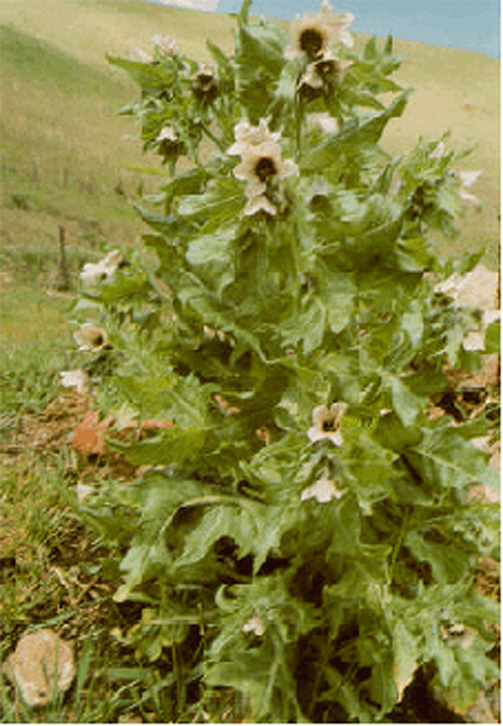






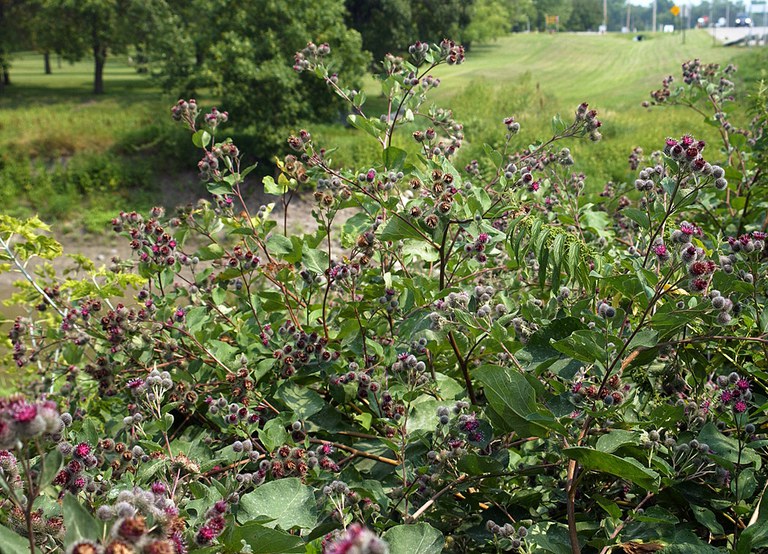























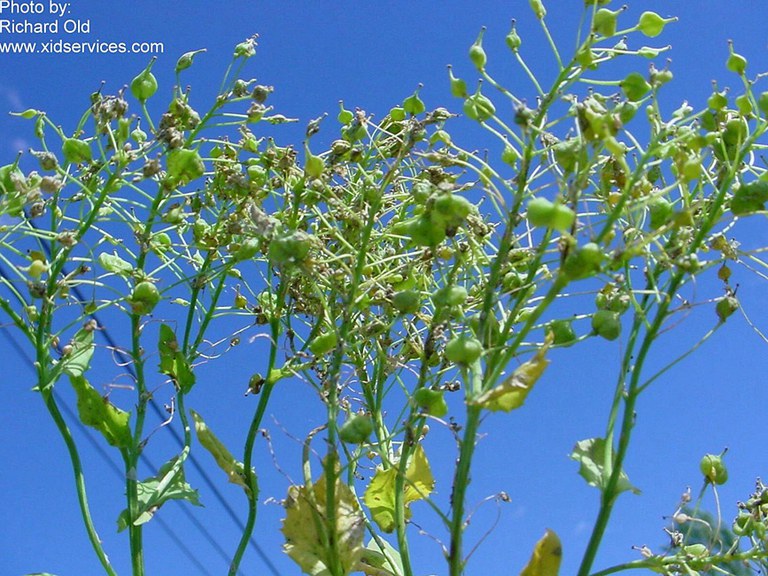
















































![[Toxiodendron rydbergii (Small ex Rydb.) Greene]](/agriculture/sites/default/files/2022-06/rgb-p40-poison-ivy-pla-opt.jpeg)


